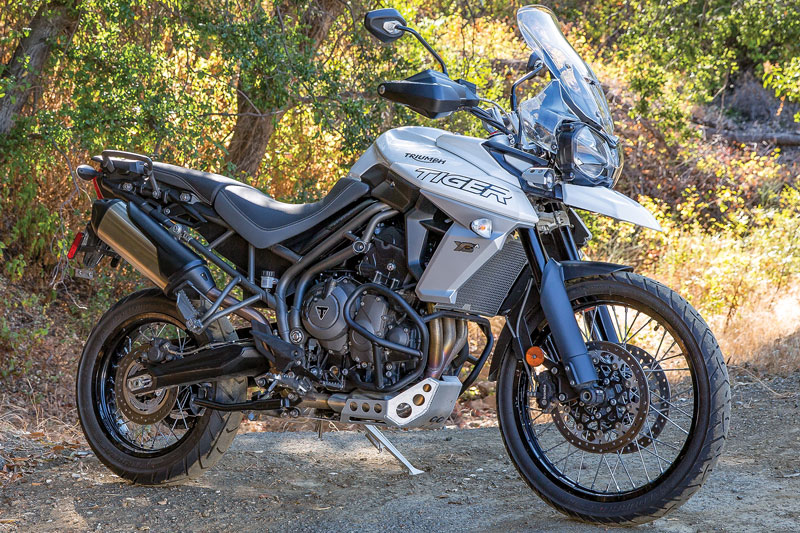2018 Triumph Tiger 800 XCA

Road Test Review
In a world flush with outstanding large adventure bikes displacing 1,200cc and more, the Triumph Tiger 800 presents a convincing argument for middleweights. We sampled 2018’s top-of-the-line off-road-oriented XCA Tiger 800 variant, which boasts more than 200 upgrades compared to the prior edition; it’s now brimming with high-tech features that deliver a ton of versatility and convenience, along with a load of thoughtful, real-world enhancements.
To some, the engine with its newly added six riding modes may deliver the biggest surprise. Refinements include a new, lower first-gear ratio for more rapid engine response, while the torque curve remains flat as can be for an impressive power hit. This engine is a runner and it builds revs with a vengeance, starting with a raspy snarl that develops into a wild-animal howl in an eager, cammy rush. It’s only during top-gear roll-on passing that the missing 400 or 500cc become apparent, so just downshift!
Otherwise, the 800 delivers all it’s got in a seamless manner that makes riding a delight. Fuel metering, throttle response, driveline lash, gearbox action, gear spacing and clutch actuation are all practically perfect, so glitches don’t intrude on the riding experience.
Our main complaint concerns engine heat that grows painfully toasty in stop-and-go traffic when air temps climb above 80 degrees, especially on the left side where hot air flows from the radiator onto the rider’s left leg virtually unimpeded. Also, a light buzz builds in the handlebar near 70 mph, then smoothes out at higher speeds; part of this is due to vibration harmonics in the handguards, a quirk common to many ADV and dual-sport bikes.
The longish 60.8-inch wheelbase lends stability, while rake and trail figures of 23.4 degrees/3.7 inches make for light, quick steering, especially given the wide handlebar and narrowed cross-section of the 21-inch front tire. A very intuitive partner, the Tiger dances beautifully down twisty roads.
Super-aggressive riding will get the front tire howling sooner than would be the case with a 19- or 17-incher due to the reduced contact patch, but all in all, it’s a non-issue for the vast majority of sporting street riding. It’s also quite comfortable for highway travel, and the new left-side cruise control button proves a welcome convenience.
New dual Brembo front brakes deliver strong stopping power and excellent feel. These twin-piston-caliper binders offer a softer initial bite compared to super-aggressive
supersport brakes, but you wouldn’t want racetrack-style braking when you’re in the dirt anyhow. We did notice the slimmer tire tends to nibble a bit while running along on freeway seams or rain grooves, but it’s a minor quirk that you’ll ignore in time.
Meanwhile, if you’re really going to get serious about off-road adventuring, the front wheel will accept DOT-approved knobby tires (tubes required) that will perform much better in the dirt, albeit at the cost of pavement performance. For hard-core dirt adventurers, the XCA now adds a sixth riding mode, Off-Road Pro, so riders can turn off the ABS and other systems for total control.
The excellent WP suspension feels firm yet compliant, and I am no lightweight. Extra off-road-oriented travel means the Tiger 800 sucks up bumps, patches and holes with ease on neglected back roads with old, broken pavement; no spine-jarring hits here, yielding a huge advantage over sportbikes and naked bikes that would struggle with less suspension travel.
Seating is upright and spacious and the seat can be altered between 33.1 inches or 33.9 inches in mere seconds. I chose the taller position to appease my aging knees, and the longer reach to the ground didn’t present any problems for me with my 31-inch inseam. The seat is wide and firm although not cushy comfortable.
A new one-hand-adjustable, spring-loaded windscreen is ingenious in design and easy to alter while underway. In the lowest of five positions the oncoming windblast strikes this six-footer right about eyebrow level, and the clean airflow creates little curl-back or buffeting. Despite their modest size, the windscreen and deflectors redirect windblast away from the rider’s torso well, producing a decent still-air pocket.
The new 5-inch, full-color TFT instrument panel stays easily readable day or night, with nice levels of contrast; the readout configuration can be custom selected to suit rider preference. Lots of the backlit switchgear has been moved to the left side of the handlebar, including a five-way joystick that greatly simplifies navigation through the many riding mode/display menus.
However, the joystick on our bike proved to be a bit sticky, locking in place until manually returned to center; hopefully this glitch is unique to our test bike, as this innovation makes it quick and easy to navigate through the plentiful mode options.
When balancing the scales, whatever edge the Tiger 800 trades away in cubic inches and punch compared to big ADV bikes, it gains back in more nimble handling, easier slow-speed maneuvering and better off-road manners thanks to a 35- to 80-pound weight savings. In short, this middleweight hits that sweet spot right in the middle. And for the Triumph Tiger 800, that’s a very good place to be.
